
Lightning strike
Encyclopedia

Lightning
Lightning is an atmospheric electrostatic discharge accompanied by thunder, which typically occurs during thunderstorms, and sometimes during volcanic eruptions or dust storms...
, typically during thunderstorm
Thunderstorm
A thunderstorm, also known as an electrical storm, a lightning storm, thundershower or simply a storm is a form of weather characterized by the presence of lightning and its acoustic effect on the Earth's atmosphere known as thunder. The meteorologically assigned cloud type associated with the...
s.
Humans can be hit by lightning directly when outdoors. Contrary to popular notion, there is no 'safe' location outdoors. People have been struck in sheds and makeshift shelters. However, shelter is possible within an enclosure of conductive material such as an automobile, which is an example of a crude type of Faraday cage
Faraday cage
A Faraday cage or Faraday shield is an enclosure formed by conducting material or by a mesh of such material. Such an enclosure blocks out external static and non-static electric fields...
.
Epidemiology
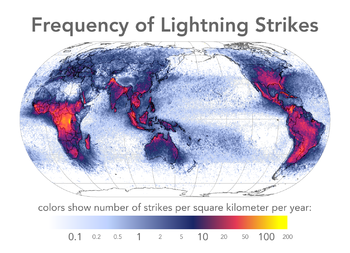
Flood
A flood is an overflow of an expanse of water that submerges land. The EU Floods directive defines a flood as a temporary covering by water of land not normally covered by water...
s). The odds of an average person living in the U.S. being struck by lightning in a given year is 1/500,000.
U.S. National Park Ranger
National Park Ranger
National Park Service Rangers are among the uniformed employees charged with protecting and preserving areas set aside in the National Park System by the United States Congress and/or the President of the United States...
Roy Sullivan
Roy Sullivan
Roy Cleveland Sullivan was a U.S. park ranger in Shenandoah National Park in Virginia. Between 1942 and 1977, Sullivan was hit by lightning on seven different occasions and survived all of them. For this reason, he gained a nickname "Human Lightning Conductor" or "Human Lightning Rod"...
has the record for being struck by lightning the most times. Sullivan was struck seven times during his 35 year career. He lost the nail on one of his big toes, and suffered multiple injuries to the rest of his body.
Human injury
Lightning strikes injure humans in several different ways:- Direct strike, which is usually fatal.
- Contact injury, when the person was touching an object that was struck
- Side splash, when current jumped from a nearby object to the victim
- Ground strike, current passing from a strike through the ground into a nearby victim. A strike can cause a difference of potential in the ground (due to resistance to current in the Earth), amounting to several thousand volts per foot.
- Blast injuries, either hearing damage or blunt trauma by being thrown to the ground.
Lightning strikes can produce severe injuries, and have a mortality rate of between 10 and 30%, with up to 80% of survivors sustaining long-term injuries. These severe injuries are not usually caused by thermal burns, since the current is too brief to greatly heat up tissues, instead nerves and muscles may be directly damaged by the high voltage producing holes in their cell membrane
Cell membrane
The cell membrane or plasma membrane is a biological membrane that separates the interior of all cells from the outside environment. The cell membrane is selectively permeable to ions and organic molecules and controls the movement of substances in and out of cells. It basically protects the cell...
s, a process called electroporation
Electroporation
Electroporation, or electropermeabilization, is a significant increase in the electrical conductivity and permeability of the cell plasma membrane caused by an externally applied electrical field...
.
In a direct hit the electrical charge strikes the victim first. If the victim's skin resistance
Electrical resistance
The electrical resistance of an electrical element is the opposition to the passage of an electric current through that element; the inverse quantity is electrical conductance, the ease at which an electric current passes. Electrical resistance shares some conceptual parallels with the mechanical...
is high enough, much of the current will flash around the skin or clothing to the ground, resulting in a surprisingly benign outcome. Metallic objects in contact with the skin may concentrate the lightning strike, preventing the flashover effect and resulting in more serious injuries. At least two cases have been reported where a lightning strike victim wearing an iPod
IPod
iPod is a line of portable media players created and marketed by Apple Inc. The product line-up currently consists of the hard drive-based iPod Classic, the touchscreen iPod Touch, the compact iPod Nano, and the ultra-compact iPod Shuffle...
suffered more serious injuries as a result. However, during a flash the current flowing around the body will generate large magnetic fields, which may induce electrical currents within organs such as the heart. This effect might explain the cases where cardiac arrest followed a lightning strike that produced no external injuries.
Splash hits occur when lightning prefers a victim (with lower resistance) over a nearby object that has more resistance, and strikes the victim on its way to ground.
Ground strikes, in which the bolt lands near the victim and is conducted through the victim and his or her connection to the ground (such as through the feet, due to the voltage gradient in the earth, as discussed above), can cause great damage.
Damage to electrical equipment
TelephoneTelephone
The telephone , colloquially referred to as a phone, is a telecommunications device that transmits and receives sounds, usually the human voice. Telephones are a point-to-point communication system whose most basic function is to allow two people separated by large distances to talk to each other...
s, modem
Modem
A modem is a device that modulates an analog carrier signal to encode digital information, and also demodulates such a carrier signal to decode the transmitted information. The goal is to produce a signal that can be transmitted easily and decoded to reproduce the original digital data...
s, computers and other electronic devices can be damaged by lightning, as harmful overcurrent
Overcurrent
In electricity supply, overcurrent or excess current is a situation where a larger than intended electric current exists through a conductor, leading to excessive generation of heat, and the risk of fire or damage to equipment. Possible causes for overcurrent include short circuits, excessive load,...
can reach them through the phone jack
Jack (connector)
In electronics and electrical assemblies, the term jack commonly refers to a surface-mounted connector, often, but not always, with the female electrical contact or socket, and is the "more fixed" connector of a connector pair...
, Ethernet cable, or electricity outlet.
A secondary effect of lightning on users of telephone equipment can be hearing damage, as the strike may cause bursts of extremely loud noise
Noise
In common use, the word noise means any unwanted sound. In both analog and digital electronics, noise is random unwanted perturbation to a wanted signal; it is called noise as a generalisation of the acoustic noise heard when listening to a weak radio transmission with significant electrical noise...
. Close strikes can also generate electromagnetic pulses (EMP
Electromagnetic pulse
An electromagnetic pulse is a burst of electromagnetic radiation. The abrupt pulse of electromagnetic radiation usually results from certain types of high energy explosions, especially a nuclear explosion, or from a suddenly fluctuating magnetic field...
s) – especially during 'positive' lightning discharges.
Trees and lightning
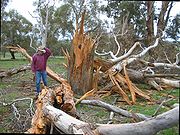
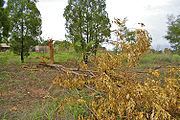
Electrical resistance
The electrical resistance of an electrical element is the opposition to the passage of an electric current through that element; the inverse quantity is electrical conductance, the ease at which an electric current passes. Electrical resistance shares some conceptual parallels with the mechanical...
causes it to be heated explosively
Steam explosion
A steam explosion is a violent boiling or flashing of water into steam, occurring when water is either superheated, rapidly heated by fine hot debris produced within it, or the interaction of molten metals A steam explosion (also called a littoral explosion, or fuel-coolant interaction, FCI) is a...
into steam, which blows off the bark
Bark
Bark is the outermost layers of stems and roots of woody plants. Plants with bark include trees, woody vines and shrubs. Bark refers to all the tissues outside of the vascular cambium and is a nontechnical term. It overlays the wood and consists of the inner bark and the outer bark. The inner...
outside the lightning's path. In following seasons trees overgrow the damaged area and may cover it completely, leaving only a vertical scar. If the damage is severe, the tree may not be able to recover, and decay sets in, eventually killing the tree. In sparsely populated areas such as the Russian Far East
Russian Far East
Russian Far East is a term that refers to the Russian part of the Far East, i.e., extreme east parts of Russia, between Lake Baikal in Eastern Siberia and the Pacific Ocean...
and Siberia
Siberia
Siberia is an extensive region constituting almost all of Northern Asia. Comprising the central and eastern portion of the Russian Federation, it was part of the Soviet Union from its beginning, as its predecessor states, the Tsardom of Russia and the Russian Empire, conquered it during the 16th...
, lightning strikes are one of the major causes of forest fires. The smoke and mist expelled by a forest fire can cause electric charges, multiplying the intensity of a forest fire. It is commonly thought that a tree standing alone is more frequently struck, though in some forested areas, lightning scars can be seen on almost every tree.
The two most frequently struck tree types are the oak
Oak
An oak is a tree or shrub in the genus Quercus , of which about 600 species exist. "Oak" may also appear in the names of species in related genera, notably Lithocarpus...
and the elm
Elm
Elms are deciduous and semi-deciduous trees comprising the genus Ulmus in the plant family Ulmaceae. The dozens of species are found in temperate and tropical-montane regions of North America and Eurasia, ranging southward into Indonesia. Elms are components of many kinds of natural forests...
. Pine
Pine
Pines are trees in the genus Pinus ,in the family Pinaceae. They make up the monotypic subfamily Pinoideae. There are about 115 species of pine, although different authorities accept between 105 and 125 species.-Etymology:...
trees are also quite often hit by lightning. Unlike the oak, which has a relatively shallow root structure, pine trees have a deep central root system that goes down into the water table. Pine trees usually stand taller than other species, which also makes them a likely target. Factors which lead to its being targeted are a high resin content, loftiness, and its needles which lend themselves to a high electrical discharge during a thunderstorm.
Trees are natural lightning conductors and are known to provide protection against lightning damage to nearby buildings. Tall trees with high biomass for the root system provide good lightning protection. An example is the teak tree (Tectona grandis). When planted near a building, its height helps to capture the oncoming lightning leader, and the high biomass of the root system helps in dissipation of the lightnings charge.
Lightning currents have a very fast risetime, on the order of 40 kA per microsecond. Hence, conductors of such currents exhibit marked skin effect
Skin effect
Skin effect is the tendency of an alternating electric current to distribute itself within a conductor with the current density being largest near the surface of the conductor, decreasing at greater depths. In other words, the electric current flows mainly at the "skin" of the conductor, at an...
, causing most of the currents to flow through the conductor skin.
Fulgurites
Lightning strikes on sandy soil can produce fulguriteFulgurite
Fulgurites are natural hollow glass tubes formed in quartzose sand, or silica, or soil by lightning strikes. They are formed when lightning with a temperature of at least instantaneously melts silica on a conductive surface and fuses grains together; the fulgurite tube is the cooled product...
s. These root-shaped tubes of melted and fused sand grains are sometimes called petrified lightning.
Airplane crashes
- On December 8, 1963, Pan Am Flight 214Pan Am Flight 214Pan Am Flight 214, a Boeing 707-121 registered as , was en route from Baltimore to Philadelphia on December 8, 1963, when it crashed near Elkton, Maryland after being hit by lightning, killing all 81 on board.-Flight history:...
crashed outside Elkton, Maryland during a severe electrical storm, with a loss of all 81 passengers and crew. The Boeing 707–121, registered as N709PA, was on the final leg of a San Juan — Baltimore — Philadelphia flight.
- On December 24, 1971 LANSA Flight 508LANSA Flight 508LANSA Flight 508 was a Lockheed L-188A Electra turboprop, registered OB-R-941, operated as a scheduled domestic passenger flight by Lineas Aéreas Nacionales Sociedad Anonima , that crashed in a thunderstorm en route from Lima, Peru to Pucallpa, Peru, on December 24, 1971, killing 91 people –...
was a Lockheed L-188A Electra turboprop, registered OB-R-941, operated as a scheduled domestic passenger flight by Lineas Aéreas Nacionales Sociedad Anonima (LANSA), that crashed in a thunderstorm en route from Lima, Peru to Pucallpa, Peru, killing 91 people – all of its 6 crew and 85 of its 86 passengers.The sole survivor was Juliane Koepcke, who fell 2 miles (3.2 km) down into the Amazon rainforest strapped to her seat and remarkably survived the fall, and was then able to walk through the jungle for 10 days until she was rescued by local lumbermen.
Lightning rods
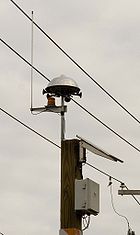
Lightning rod
A lightning rod or lightning conductor is a metal rod or conductor mounted on top of a building and electrically connected to the ground through a wire, to protect the building in the event of lightning...
s and electrical charge dissipators, are used to prevent lightning damage and safely redirect lightning strikes.
A lightning rod (or lightning protector) is a metal
Metal
A metal , is an element, compound, or alloy that is a good conductor of both electricity and heat. Metals are usually malleable and shiny, that is they reflect most of incident light...
strip or rod, usually of copper
Copper
Copper is a chemical element with the symbol Cu and atomic number 29. It is a ductile metal with very high thermal and electrical conductivity. Pure copper is soft and malleable; an exposed surface has a reddish-orange tarnish...
or similar conductive material, used as part of lightning safety to protect tall or isolated structures (such as the roof of a building or the mast of a vessel) from lightning
Lightning
Lightning is an atmospheric electrostatic discharge accompanied by thunder, which typically occurs during thunderstorms, and sometimes during volcanic eruptions or dust storms...
damage. Its formal name is lightning finial or air terminal. Sometimes, the system is informally referred to as a lightning conductor, arrester, or discharger; however, these terms actually refer to lightning protection system
Lightning protection system
A lightning protection system is a system designed to protect a structure from damage due to lightning strikes by intercepting such strikes and safely passing their extremely high voltage currents to "ground"...
s in general or specific components within them. Lightning protection systems alter lightning streamer behavior.
The field of lightning protection is almost totally void of systems or concepts designed to deal with the general problem area as a whole. Chaff and silver iodide crystals concepts were devised to deal directly with the cloud cells and were dispensed directly into the clouds from an overflying aircraft. The chaff was devised to deal with the electrical manifestations of the storm from within, while the silver iodide salting technique was devised to deal with the mechanical forces of the storm.
Predicting strikes
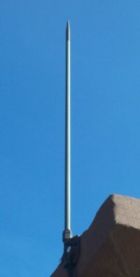
Lightning interferes with AM (amplitude modulation
Amplitude modulation
Amplitude modulation is a technique used in electronic communication, most commonly for transmitting information via a radio carrier wave. AM works by varying the strength of the transmitted signal in relation to the information being sent...
) radio signals much more than FM (frequency modulation
Frequency modulation
In telecommunications and signal processing, frequency modulation conveys information over a carrier wave by varying its instantaneous frequency. This contrasts with amplitude modulation, in which the amplitude of the carrier is varied while its frequency remains constant...
) signals, providing an easy way to gauge local lightning strike intensity. To do so, one should tune a standard AM medium wave receiver to a frequency with no transmitting stations, and listen for crackles amongst the static
Noise (radio)
In radio reception, noise is the superposition of white noise and other disturbing influences on the signal, caused either by thermal noise and other electronic noise from receiver input circuits or by interference from radiated electromagnetic noise picked up by the receiver's antenna...
. Stronger or nearby lightning strikes will also cause cracking if the receiver is tuned to a station.
Lightning prediction system
Lightning prediction system
A lightning prediction system detects atmospheric conditions likely to produce lightning strikes in a certain area and sounds an auditory alert, warning those nearby that lightning is imminent and giving them the chance to find safety before the storm actually impacts the area...
s have been developed and may be deployed in locations where lightning strikes present special risks, such as public parks. Such systems are designed to detect the conditions which are believed to favor lightning strikes and provide a warning to those in the vicinity to allow them to take appropriate cover.
The National Lightning Safety Institute recommends using the F-B (flash to boom) method. The flash of a lightning strike and resulting thunder occur at roughly the same time. But light travels at 300,000 kilometers in a second, almost a million times the speed of sound. Sound travels at the slower speed of 344 m/s so the flash of lightning is seen before thunder is heard. To use the method, count the seconds between the lightning flash and thunder. Divide by 3 to determine the distance in kilometers, or by 5 for miles. All of the precautions above should be taken from the time the F-B is 25 seconds or less, that is, the lightning is closer than 8 km (5 mi). Do not rely on the F-B method for determining when to relax the safety measures, because lightning typically occurs in multiple locations, and just because some strikes are far away does not mean another is not close. Precautions should not be relaxed until thunder cannot be heard for 30 minutes.
Personal safety
The US National Lightning Safety Institute advises everyone to have a plan for their safety when a thunderstorm occurs and to commence it as soon as the first lightning or thunder is observed. This is important, since lightning can strike without rain actually falling. If thunder can be heard at all then there is a risk of lightning. The safest place is inside a building or a vehicle. Risk remains for up to 30 minutes after the last observed lightning or thunder.If a person is injured by lightning they do not carry an electrical charge and can be safely handled to apply first aid
First aid
First aid is the provision of initial care for an illness or injury. It is usually performed by non-expert, but trained personnel to a sick or injured person until definitive medical treatment can be accessed. Certain self-limiting illnesses or minor injuries may not require further medical care...
before emergency services arrive. Lightning can affect the brainstem, which controls breathing. If a victim appears lifeless, it is important to begin artificial resuscitation immediately to prevent death by suffocation.
See also
- KeraunomedicineKeraunomedicineKeraunomedicine is the medical study of lightning casualties. The term may have been coined by Chris Andrews, a lightning and electrical injury researcher. Lightning injuries result from three factors: electrical damage, intense heat, and the mechanical energy which these generate...
, the medical study of lightning casualties and their treatment - KeraunopathyKeraunopathyKeraunopathy is the medical science of the effects of lightning strikes on the human body, which is characterized by the small number of experts available in the field...
, the study of the effects of lightning strikes on the human body

